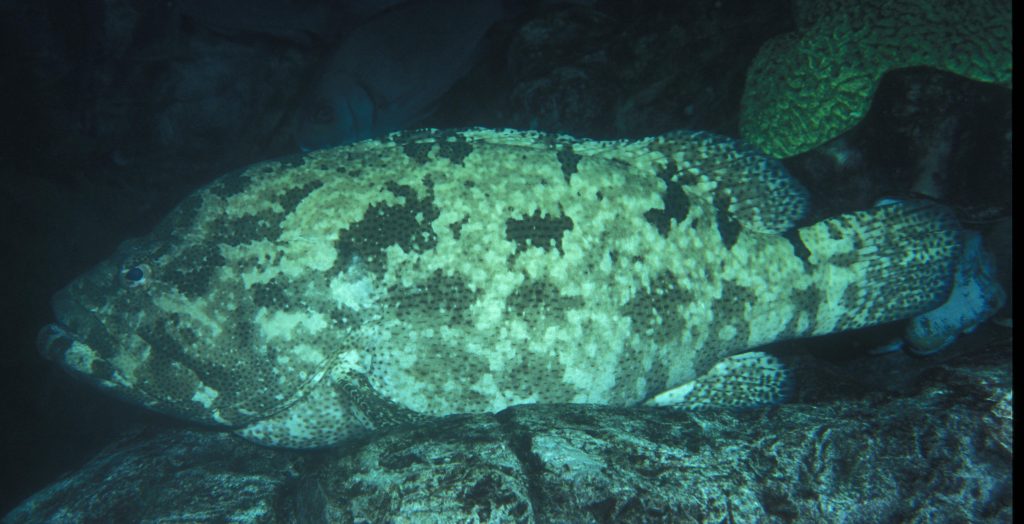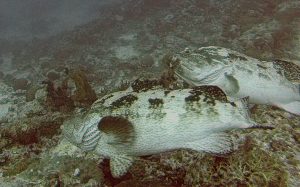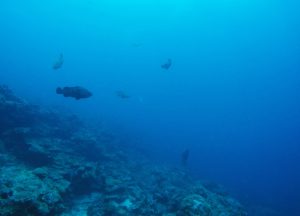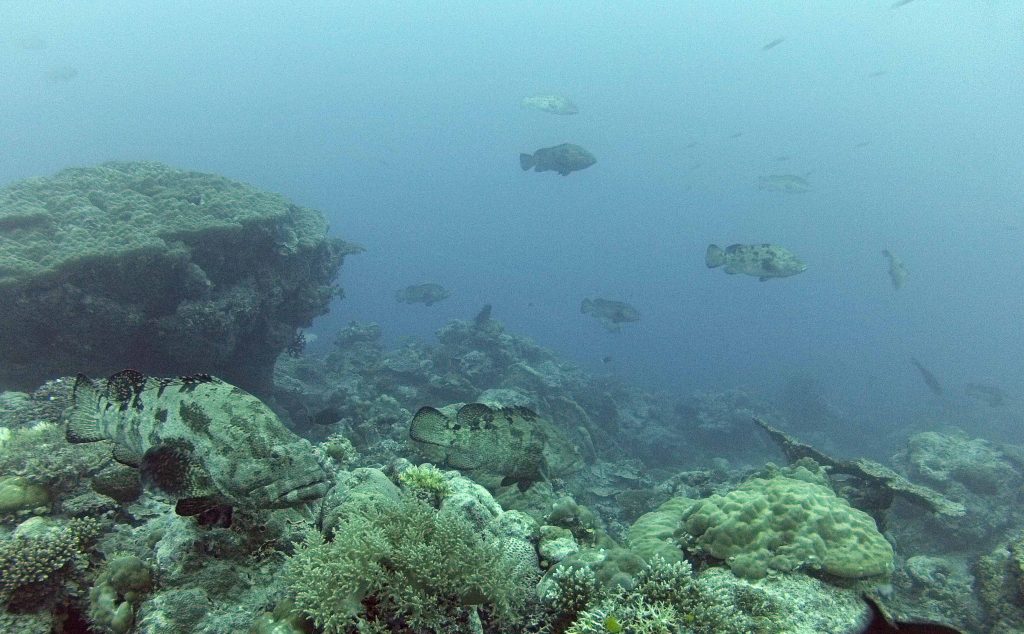IUCN Red List Assessment VULNERABLE (2018)
Range Description: The brown-marbled grouper is distributed in the Indo-Pacific, along east Africa from Mozambique to the Red Sea, east to Samoa and the Phoenix Islands, north to Japan and south to Australia. It is not known from the Persian Gulf, Hawaii and French Polynesia. It is also recorded from Hibernia Reef in the Timor Sea south of Timor-Leste and Pratas Island (Dong Sha) in the South China Sea. Its depth range is 1-70 metres. See IUCN Red List assessment for map and full country list.

Credit: Jack Randall
Species Summary: The species occurs as adults in lagoons and around patch reefs, channels and along outer reef slopes in clear water and where coral is abundant. Juveniles inhabit seagrass beds and estuarine or low salinity inshore areas. In Australia, the size at 50% sexual maturity for females is 57 cm fork length and about 9 years of age, with a maximum reported age of 42 years. Its maximum total length is 120 cm. The species is a protogynous hermaphrodite in which juveniles mature as females which then, when older and larger, change sex to produce males. Some females may never undergo sex change.
This species is relatively uncommon and typically forms transient spawning aggregations of tens (where exploited) to a few hundreds or thousands of fish during several (usually 2-4) months of the year to reproduce. Significant population declines have occurred in areas where spawning aggregations have been exposed to heavy and unmanaged fishing pressure. Countries where aggregations have been fished to very low abundances include the following; Micronesia, the Philippines, Indonesia, the Maldives, Malaysia, Thailand, the Solomon Islands, Palau and Fiji. A total of 55 aggregations have been documented for this species in the SCRFA database It utilizes migratory corridors to reach spawning aggregation sites (a travel distance of up to 25 km), and males tend to arrive at their aggregations prior to females during the spawning season.

Brown-marbled grouper spawning aggregations overlap somewhat spatially and temporally with those of camouflage grouper (Epinephelus polyphekadion) and the squaretailed coral grouper (Plectropomus areolatus) but the species generally in deeper waters compared to P. areolatus. Individuals exhibit a range of body patterning during aggregations with interacting males sometimes lightening. In the days leading up to spawning, more and more activity is seen up in the water column, again with fish taking on different body shades
 Fisheries: Heavy exploitation of spawning aggregations and the catch of wild juveniles for aquaculture grow-out are major threats to this species. Secondary threats include the degradation of seagrass beds and coral reefs due to coastal development and climate change. The species is taken in coastal reef fisheries in much of its range and is valued in the international live fish trade in SE Asia, fetching a high price at retail. It has been part of this trade for several decades but there has also recently been growth in the international marketing of chilled/frozen fish, for example out of Indonesia and the Maldives, as demand for groupers increases. Fish sizes in trade can be quite small, with more and more juveniles being sold, including for grow-out, which persists even though this species is extensively hatchery produced. Juvenile size ranges are particularly appropriate for dinner plates. Due to overfishing and its longevity, which make the species particularly easy to overfish, the species is declining in many areas and is listed as threatened globally (Vulnerable) on the IUCN Red List (2018).
Fisheries: Heavy exploitation of spawning aggregations and the catch of wild juveniles for aquaculture grow-out are major threats to this species. Secondary threats include the degradation of seagrass beds and coral reefs due to coastal development and climate change. The species is taken in coastal reef fisheries in much of its range and is valued in the international live fish trade in SE Asia, fetching a high price at retail. It has been part of this trade for several decades but there has also recently been growth in the international marketing of chilled/frozen fish, for example out of Indonesia and the Maldives, as demand for groupers increases. Fish sizes in trade can be quite small, with more and more juveniles being sold, including for grow-out, which persists even though this species is extensively hatchery produced. Juvenile size ranges are particularly appropriate for dinner plates. Due to overfishing and its longevity, which make the species particularly easy to overfish, the species is declining in many areas and is listed as threatened globally (Vulnerable) on the IUCN Red List (2018).
Management/Conservation: Despite declines and its threatened status, the marbled grouper receives little management or conservation protection in much of its range. Exceptions include protection of some of its spawning aggregations and minimum size measures to protect juveniles and allow them to reach reproductive size and age. For example, sales (Pohnpei, Palau) and catch bans (Palau, Fiji, Solomon Islands) are in place during all or most of the reproductive season. No-take protected areas specific to spawning aggregation sites are in place in Palau, Pohnpei and the Solomon Islands. The Maldives has introduced minimum capture and trade sizes for the species, while Australia has catch quotas and minimum size limits. In the Great Barrier Reef Australia, this species is managed with no-take marine protected areas, size and catch limits and seasonal spawning closures.

Credit: Ebill Cam
Key Recent Publications on biology, trade, fisheries and management: for earlier publications, please refer to IUCN Red List Assessment and https://www.springer.com/gp/book/9789400719798
Bijoux, J., Dagorn, L., Cowley, P.D., Simier, M., Adam, P-A., and Robinson, J. (2013) Spawning aggregation dynamics of brown-marbled grouper and camouflage grouper at a remote Indian Ocean atoll. Endang. Species Res. 22, 145–157
FISHBASE: https://www.fishbase.se/summary/Epinephelus-fuscoguttatus.html
Rhodes, K., Sadovy, Y. & Samoilys, M.(2018). Epinephelus fuscoguttatus.The IUCN Red List of Threatened Species 2018: e.T44673A100468078.
Rhodes, K.L., Nemeth, R.S., Kadison, E. and Joseph, E. (2014). Spatial, temporal and environmental dynamics of a multi-species spawning aggregation in Pohnpei, Micronesia. Coral Reefs 33: 765-775.
Robinson, J., and Samoilys, M., A. (Co-editors) (2013). Reef Fish Spawning Aggregations in the Western Indian Ocean: Research for Management. WIOMSA/SIDA/SFA/CORDIO. WIOMSA Book Series 13
Robinson, J., Graham, N. A. J., Cinner, J. E., Almany, G.R. and Waldie, P. (2015). Fish and fisher behaviour influence the vulnerability of groupers (Epinephelidae) to fishing at a multispecies spawning aggregation site. Coral Reefs 34, 371-382.
Waldie, P.A., Almany, G.R., Sinclair-Taylor, T.H., Hamilton, R.J., Potuku, T., Priest, M.A., Rhodes, K.L., Robinson, J., Cinner, J.E. and Berumen, M.L. (2016). Restricted grouper reproductive migrations support community-based management. Royal Society Open Science: DOI: 10.1098/rsos.15069
Hamilton, R.H., Potuku, T. and Monambault, J.R. (2016). Community-based conservation results in the recovery of a reef fish spawning aggregations in the Coral Triangle. Biological Conservation 144, 1850- 1858
Hughes A. T, Hamilton R. J, Choat J. H, Rhodes K. L (2020) Declining grouper spawning aggregations in Western Province, Solomon Islands, signal the need for a modified management approach. PLoS ONE 15(3): e0230485.
Khasanah, M., Sadovy de Mitcheson, Y., Kadir, N. N. & Jamaluddin J. (2020). Management of Grouper Export Trade in Indonesia Reviews in Fisheries Science & Aquaculture; 10.1080/23308249.2018.1542420
Kindsvater, H. Reynolds, J. Sadovy de Mitcheson, Y. Mangel, M. 2017. Selectivity matters: rules of thumb for management of plate-sized, sex-changing fish in the live reef food fish trade. Fish and Fisheries: 18:821-836 /doi/10.1111/faf.12208/abstract
Ma, K. Y., van Herwerden, L., Newman, S. J., Berumen, M. L., Choat, J. G., Chu, K. H. and Sadovy de Mitcheson, Y. (2018). Contrasting population genetic structure in three aggregating groupers (Percoidei: Epinephelidae) in the Indo-West Pacific: the importance of reproductive mode. BMC Evol Biol. 2018; 18: 180. doi:10.1186/s12862-018-1284-0. https://www.ncbi.nlm.nih.gov/pmc/articles/PMC6278153/
Samoilys, MA, Macharia, D, Robinson, J, Maina, GW, Bijoux J (2013). Observations of spawning aggregations of the brown-marbled grouper, Epinephelus fuscoguttatus, in Kenya. In: Robinson J, Samoilys MA (eds) Reef fish spawning aggregations in the Western Indian Ocean: Research for management. WIOMSA/CORDIO, Nairobi, pp 63-74
Samoilys, M. A., Macharia, D., Robinson, J., Maina, G. W., and Bijoux J. (2015). Confirmed Sighting of a Spawning Aggregation of the Brown-marbled Grouper, Epinephelus fuscoguttatus, in Kenya. Western Indian Ocean J. Mar. Sci. Vol. 13. No. 2, pp. 189 – 203 , 2014 © 2015 WIOMSA
Sattar, S.A., Wood, E., Islam, F., Najeeb, A. (2014). Current status of the reef fisheries of Maldives and recommendations for management. Darwin Reef Fish Project. Marine Research Centre/ Marine Conservation Society (UK).
For current perspectives on live reef fish trade in Southeast Asia, there are two recent publications:
Online visual sources:
Nice interaction (not aggression) between male and female (you can see a slightly gravid female-with eggs) and male colour changes on 16 April 2020, 7 days before new moon which could be a spawning time. Film from Richard Brooks